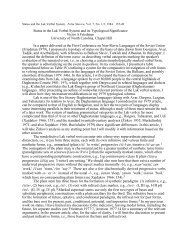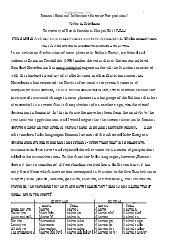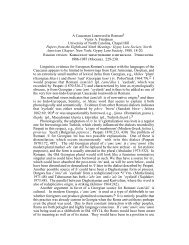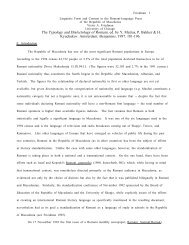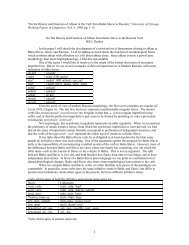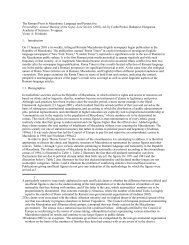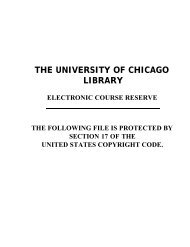Makedonia ve Civar Bölgelerde Balkan Türkçesi / Balkan Turkish in ...
Makedonia ve Civar Bölgelerde Balkan Türkçesi / Balkan Turkish in ...
Makedonia ve Civar Bölgelerde Balkan Türkçesi / Balkan Turkish in ...
Create successful ePaper yourself
Turn your PDF publications into a flip-book with our unique Google optimized e-Paper software.
Turkey but be ma<strong>in</strong>ta<strong>in</strong>ed <strong>in</strong> WRT pr<strong>in</strong>t media, e.g. nen 'th<strong>in</strong>g' <strong>ve</strong>rsus the Standard <strong>Turkish</strong><br />
Arabism s¸ey (Teodosijevic´ 1987:187). A lexical feature of colloquial WRT that is specific to its<br />
context is the reborrow<strong>in</strong>g of words that the contact languages orig<strong>in</strong>ally borrowed and<br />
subsequently altered. Thus the "Turkisms" of Macedonian and Albanian become "contact"<br />
elements <strong>in</strong> WRT when it reborrows them, as shown <strong>in</strong> the follow<strong>in</strong>g examples:<br />
(18) piper = biber (Zekeriya 1976:.17, cf. Caferog˘lu 1959:250)<br />
(19) demirliya = demirli 'iron' (Bayram 1985)<br />
The facts of WRT raise a number of <strong>in</strong>terest<strong>in</strong>g questions concern<strong>in</strong>g mechanisms,<br />
effects, and ideology <strong>in</strong> language contact. On the phonological le<strong>ve</strong>l the most noteworthy<br />
phenomena are the elim<strong>in</strong>ation of consonant and vowel phonemes not represented <strong>in</strong> the contact<br />
languages, e.g.. /ö/ and /h/, the migration of high back unrounded /i- / to a more central or otherwise<br />
altered position, and the <strong>in</strong>troduction of a dental affricate /c/. The palatalization of <strong>ve</strong>lars before<br />
front vowels and merger with palatal affricates also parallels processes <strong>in</strong> the contact dialects, as<br />
do phonotactic processes such as the elim<strong>in</strong>ation of gem<strong>in</strong>ates and the treatment of /l/. The<br />
result<strong>in</strong>g phonological <strong>in</strong><strong>ve</strong>ntories of WRT dialects look <strong>ve</strong>ry much like those of the non-<strong>Turkish</strong><br />
dialects with which they are <strong>in</strong> contact.<br />
On the morphophonemic le<strong>ve</strong>l, confusion <strong>in</strong> the system of vowel harmony, while<br />
possibly an archaism, also reflects the lack of vowel harmony <strong>in</strong> the contact languages, WRT<br />
<strong>in</strong>flection has rema<strong>in</strong>ed otherwise unaffected, although the dati<strong>ve</strong>-locati<strong>ve</strong> confusion (generally <strong>in</strong><br />
favor of the locati<strong>ve</strong>) is an <strong>in</strong>terest<strong>in</strong>g counterexample to the claim that the transparency of<br />
<strong>Turkish</strong> <strong>in</strong>flection makes it resistant to contact (cf. Johanson 1992:231). Howe<strong>ve</strong>r, this and the<br />
borrow<strong>in</strong>g of the vocati<strong>ve</strong> affix -- which can be treated as lexical or derivational -- demonstrate<br />
that on the whole the WRT <strong>in</strong>flectional system is remarkably resistant. (The replacement of<br />
nonf<strong>in</strong>ite with f<strong>in</strong>ite clauses also affects <strong>in</strong>flection, but only <strong>in</strong>sofar as there is a shift from<br />
<strong>in</strong>flection to syntax to con<strong>ve</strong>y some types of <strong>in</strong>formation.) The derivational system has been<br />
<strong>in</strong>fluenced precisely <strong>in</strong> those areas where the contact languages differ, e.g. the borrow<strong>in</strong>g of<br />
fem<strong>in</strong><strong>in</strong>e gender markers for animate be<strong>in</strong>gs, or where they are particularly salient, e.g. <strong>in</strong><br />
dim<strong>in</strong>uti<strong>ve</strong> markers. Also of significance may be the exaggerated productivity of nati<strong>ve</strong> affixes<br />
that are borrowed and producti<strong>ve</strong> <strong>in</strong> the contact languages.<br />
The realm of syntax, which is where Standard <strong>Turkish</strong> and the <strong>Balkan</strong> languages display<br />
their most salient differences, shows an especially strong tendency <strong>in</strong> WRT toward<br />
accommodation. In the noun phrase, there is the tendency to confuse dati<strong>ve</strong> and locati<strong>ve</strong> case<br />
functions, to copy patterns of modifier agreement and to use head-geniti<strong>ve</strong> word order. In the<br />
<strong>ve</strong>rb phrase, the tendency is to elim<strong>in</strong>ate nonf<strong>in</strong>ite forms by substitut<strong>in</strong>g <strong>in</strong>flected<br />
(optati<strong>ve</strong>/subjuncti<strong>ve</strong> or conditional) forms for <strong>in</strong>f<strong>in</strong>iti<strong>ve</strong>s and analytic connecti<strong>ve</strong>s for participles.<br />
E<strong>ve</strong>n the <strong>in</strong>flection for <strong>in</strong>terrogation and negativity is sometimes replaced by a lexical items based<br />
on Slavic models. In sentential word order WRT arguably displays strong contact <strong>in</strong>duced<br />
<strong>in</strong>fluence.<br />
In the lexicon, aside from calques and loanwords, some of which ha<strong>ve</strong> affected the<br />
phonological system, there are phenomena specific to the situation of WRT as a formerly<br />
dom<strong>in</strong>ant language now both subord<strong>in</strong>ate and beyond the borders of the centers of<br />
standardization. The phenomenon of reborrow<strong>in</strong>g loanwords <strong>in</strong> the shape they acquired <strong>in</strong> the<br />
languages that orig<strong>in</strong>ally borrowed them reflects a change <strong>in</strong> dom<strong>in</strong>ance relations. Similarly,<br />
whereas <strong>Turkish</strong> was the source for all sorts of expressions <strong>in</strong> Slavic relat<strong>in</strong>g to e<strong>ve</strong>ryth<strong>in</strong>g from<br />
e<strong>ve</strong>ryday life to state adm<strong>in</strong>istration, the opposite is now the case, with Slavic (and, where it is<br />
numerically dom<strong>in</strong>ant, also Albanian) serv<strong>in</strong>g as the source for numerous borrow<strong>in</strong>gs <strong>in</strong>to WRT.<br />
8



